Articles and News
How To Help Your Customers Find And Wear The Right Earrings | July 23, 2014 (1 comment)
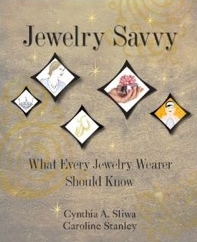
Merrick, NY—Earrings are a wardrobe staple for most women and you, as a sales associate, are perfectly positioned to help them find the right earrings. Earrings they will wear, not ones that will sit in a drawer! Following is a short excerpt from Jewelry Savvy: What Every Jewelry Wearer Should Know by Cynthia Sliwa, my co-author and myself. Use it as a quick primer to help your customer choose the best earrings.
Once you've read through the information below, do your homework before the next customer comes in.
- Identify a number of basic studs that will look great on anyone and group them near each other. Ensure that you cover a range of types (diamond, gemstone, metal, pearls, etc.) and price ranges.
- Group earrings together that are one inch in diameter and smaller that sit on the ear. Along with the studs, these will work on most women.
- Choose four or five pairs of earrings that drop down from the ear and arrange them from shortest to longest. When your next customer comes in that this look suits, find the length of earring that flatters her best, starting from one end to the other.
As always, be prepared and never practice on the customers!
How to Choose Earrings that Flatter
Consider Your Ears. Have you ever really looked at the size and shape of your ears? Chances are, unless there is something about your ears that you specifically don’t like, you’ve never given them much thought. Ears can be large or small, relative to the size of your head and facial features. They can be prominently set at an angle, or they can unobtrusively lie flat against the side of your head. The tops of the ears can start high on the sides of the face, or low. And earlobes can range from large to nonexistent. All of these variations should be considered when selecting earrings that are right for you.
If you love the appearance of your ears, try pierced clip-back or shepherd’s hook earrings, which completely expose and therefore highlight beautifully shaped ears. Be careful about scale, however. As a general rule, delicate wires or shepherd’s hooks look best on smaller ears. For larger ears we recommend a heavier shepherd’s hook, or earrings that cover the earlobe.
If you dislike the appearance of your ears, perhaps you’ve decided that earrings are not for you. This need not be the case. Seek styles that completely cover the earlobes, such as button shapes or other large designs.
If your ears are prominent and protrude, rather than lie flat against your head, try earrings with some width rather than narrow linear designs.
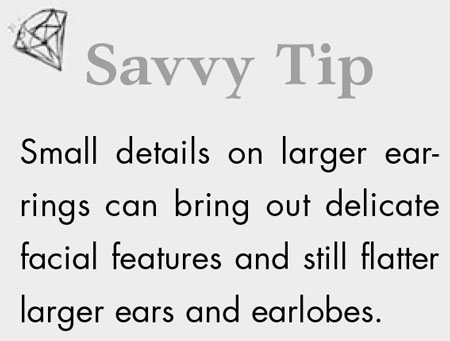
Asymmetrical Ears. Most of us have some asymmetry in our ears, but unless the bottoms of the ears are at significantly different heights, it is unnoticeable, and therefore does not affect jewelry choice.
If the bottoms of your ears are at noticeably different heights, we recommend making this asymmetry a signature of your style. Consider wearing two markedly different earrings or wearing two earrings in one ear and one in the other. Incidentally, sometimes the placement of the holes in your earlobes causes earrings to hang at different heights. An experienced piercer should be able to place the holes at equal heights. However, if you are unhappy with the placement of your piercing holes, consider letting one or both of them close up and having your ears re-pierced.
Consider the Shape of Your Face. Understanding how earrings work with the shape of your face is key. (We discuss face shape at length in Chapter 9, and we urge you to take a moment to learn how to assess the shape of your face.) Basically, earrings that repeat the overall shape of your face bring emphasis to its shape.
Most fashion books will advise you to camouflage elements of your face that deviate from the oval shape, but we say whether to accentuate or downplay the shape of your face is entirely your choice.


In this illustration, the square earrings with strongly angular motifs repeat, and therefore highlight, the strong square jawline of the model. The oval earrings shown to the right have the effect of softening the angular lines of her bone structure.
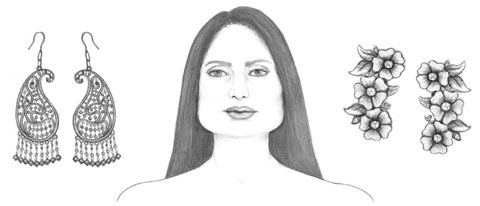
In this illustration, the dangling paisley-shaped earrings bring the eye downward and emphasize the model’s triangular-shaped face. The earrings shown to the right, which sit on, not below, the ears, add width to the mid-point of the model’s face, camouflaging its strong, triangular shape.
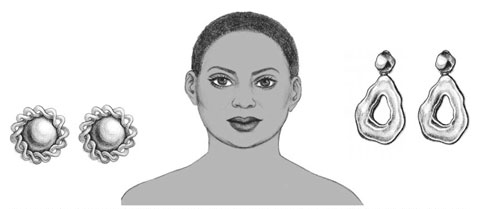
In this illustration, the button-shaped earrings emphasize the model’s round face. The drop earrings to the right contain curved lines that relate to the model’s face and features, but also introduce elongating vertical lines that distract from and downplay the roundness of her face.
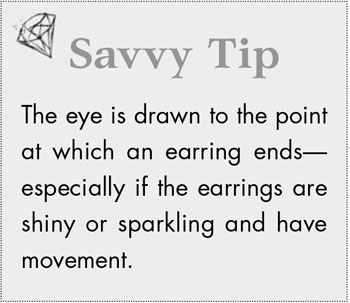
Focus on Your Face. To focus maximum attention on your face, wear your earrings no longer than your jawline. If you have a square jawline, or a triangular or inverted oval face (where the jaw is wider than the hairline), you may find you prefer shorter earrings that visually stop above the jawline and deflect from emphasis at the lowest point of the face.
Camouflage the Signs of Aging. Dangling earrings have a tendency to emphasize drooping and sagging features. Earrings on French wires or shepherd’s hooks, or any earrings with a minimal point of contact with the earlobes, draw the eye down to a point below the ears, away from the eyes and even away from the mouth. At the same time, the wires can mirror fine lines on the face, especially those around the mouth, which are nearest to the earrings.
Notice the point on your face or neck at which a pair of earrings ends. This is the point to which the eye will be drawn. If you have sun-damaged skin on your neck, or jowls, or multiple chins, consider whether you want that area to be the focal point and choose earrings accordingly.
Consider Your Nose. Earrings with a vertical emphasis repeat and emphasize the vertical lines of the face, including the strongest vertical element on the face, the nose. One of the most common mirroring effects occurs when the shape and size of earrings correlates with the shape and size of the nose. In that case, the nose comes into prominent focus.
When earrings are reminiscent of the nose, repeating the shape but not also the size of the nose, the earrings will be subtly flattering to the wearer.
Consider Your Neck and the Height of Your Ears. The length and width of your neck and the placement of your ears come into play in choosing drop earrings. As a general rule, the longer your neck, the greater the range of earring lengths that will flatter you. If you have a short neck, stud earrings or earrings that focus attention at the level of your earlobe may be a more flattering choice than drop earrings.
Note, too, that the height of your ears—their placement along the side of your head—will affect the relative height of your earlobes and the amount of space between your earlobes and shoulders.
A Fool-Proof Look. If you are having trouble choosing earrings for yourself, if you just don’t want to have to think about coordinating a pair with an outfit, or even if you’re choosing a gift of earrings for someone else, there are several shapes of earrings that work for most ears and most personality types:
- Stud earrings of most any type (pearl, diamond, gemstone, or metal). Try to purchase in proportion to the size of the earlobes if possible.
- ¾-inch to 1-inch diameter shell-shaped earrings (illustrated).
- ¾-inch to 1-inch diameter round or oval hoop earrings. All three of these styles are appropriate for a professional work environment, with the caveat that diamonds may be considered too flashy for daytime wear in the most conservative workplaces. A good rule of thumb for business is to wear earrings no larger than the diameter of a quarter or approximately one inch in height and width. These three categories encompass hundreds and hundreds of styles. Keep at least one pair on hand for an all-purpose, not-too-much-thought-required option for any occasion.
Cynthia Sliwa, co-author of Jewelry Savvy: What Every Jewelry Wearer Should Know, is a freelance writer and image consultant. She authored the Jewelry Fashion File blog for jckonline.com for over five years. Her current blog trulyjewelry.com reports on jewelry style trends and "the what, why & how of wearing jewelry well."







